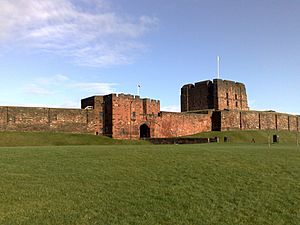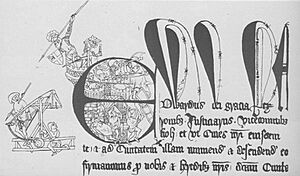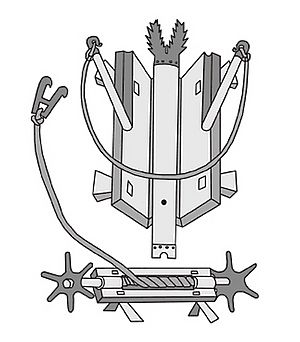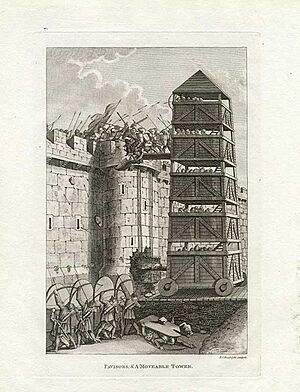Siege of Carlisle (1315) facts for kids
Quick facts for kids Siege of Carlisle (1315) |
|||||||
|---|---|---|---|---|---|---|---|
| Part of the First War of Scottish Independence | |||||||
 Carlisle Castle, modern day |
|||||||
|
|||||||
| Belligerents | |||||||
| Kingdom of England | Kingdom of Scotland | ||||||
| Commanders and leaders | |||||||
| Sir Andrew Harclay | Robert the Bruce James Douglas |
||||||
| Strength | |||||||
| Unknown | 10,000 | ||||||
The Siege of Carlisle was a big battle that happened from July 22 to August 1, 1315. It was part of the First War of Scottish Independence. This fight took place near the town of Carlisle in Cumbria, England.
After winning the Battle of Bannockburn in 1314, Robert the Bruce, who was the King of Scotland, sent his armies to raid areas in Northern England. Many places along the border between Scotland and England were claimed by both sides. Carlisle was one of these important places. It controlled a key route into North-West England.
Carlisle Castle was a very strong fortress. It was defended by soldiers led by Sir Andrew Harclay. He was a very experienced soldier. Even though the Scots had won big battles, they weren't very good at long sieges. They didn't have the right tools or enough supplies. After trying and failing to break through the castle walls, they left on August 1.
This victory was very important for Harclay. It helped him become famous. He was later made the Earl of Carlisle.
Contents
Why Carlisle Was Important
Carlisle's History
The town of Carlisle and its castle were like a main base in the west for the Scottish Marches. This was a special area along the border between Scotland and England. It was a buffer zone, meaning it helped separate the two countries. Carlisle was very important because it controlled who could get into North West England. It was as important as Berwick was for the North East. This made Carlisle a key place in the fights between Scotland and England.
Carlisle had been attacked many times before. It was besieged seven times between 1171 and 1461. The siege in 1315 was one of the most serious attacks. The first fort in Carlisle was built in 72 CE by the Romans. It was made of wood and earth. Later, in 1092, William II of England built a stone castle on the same spot. Other kings made it even bigger over time.
The Wars for Scottish Freedom
The Scottish Wars of Independence began after Alexander III of Scotland died in 1286. Then, his granddaughter Margaret, Maid of Norway also died in 1290. This meant there were many people who wanted to be the King or Queen of Scotland. They asked Edward I of England to help them decide. In return, they agreed that Edward had some power over Scotland. But when Edward chose John Balliol as king, some rivals didn't like it. When Edward tried to control Scotland too much, Balliol was removed from power. The Scots then made an alliance with France against England. This alliance was called the Auld Alliance.
Edward I invaded Scotland in 1296. He won some early battles. This started the First War of Scottish Independence. Even with heroes like William Wallace, the Scots were still fighting England in 1314. That year, Robert the Bruce, who was now King of Scotland, defeated Edward II of England at the Battle of Bannockburn. This victory united Scotland under his leadership.
Scottish raids into Northern England had started in 1311. They continued even after Bannockburn. The attack on Carlisle might show that the Scots were feeling very confident. Or, it might have been part of a plan to capture important border castles like Carlisle and Berwick. Besides taking castles, these attacks into England also aimed to make Edward II accept that Scotland was an independent country.
The Siege Begins
English Defenders
The English expected Carlisle to be attacked after their defeat at Bannockburn. So, they made the castle's defenses stronger. Six months before the siege, Andrew Harclay was in charge of the castle. He commanded a few hundred regular soldiers. People from the nearby areas would have also come inside the walls for safety. It's likely that Harclay and his men had fought at Bannockburn. They would have also gained experience from smaller fights along the border. The defenders had catapults and springalds. These machines could throw large bolts and rocks down onto the attackers.
Scottish Attackers
The Scottish army was led by their king, Robert the Bruce. They had proven how strong they were at Bannockburn. However, they were not very experienced at attacking castles in a long siege. Bruce usually preferred to take castles by surprise. He would often use small, secret attacks at night. One time, at the siege of Edinburgh, a large group of soldiers created a distraction. This allowed a smaller group to climb over the wall.
During the siege of Carlisle, the Scottish army used typical siege equipment for that time.
How the Siege Happened
Bruce arrived outside Carlisle on July 22. He started by destroying the towns outside the castle walls. He also ruined the local crops. The Scots first attacked the castle gates. But they were pushed back and lost many soldiers. Then, they built a catapult. However, it couldn't do much damage to the strong walls.
Next, they built a siege tower. They also filled the castle moat (the ditch around the castle) with hay and other materials. Their plan was to attack the walls directly. But the weather stopped both of these plans. The siege tower got stuck. And the materials filling the ditch were washed away by rain. They tried to get into the castle using long ladders and bridges over the moat. They also used a "sow." This was a mobile shelter that protected soldiers trying to dig under the walls. But none of these attempts worked.
In a final effort, Bruce tried a tactic he used to capture Edinburgh. He launched attacks in different places to distract the defenders. While this was happening, James Douglas attacked the walls from a side that hadn't been attacked before. This plan also failed. The siege ended on August 1 when the Scots left. They might have heard that English help was coming. Or, they might have heard about a defeat suffered by Edward Bruce in Ireland.
What Happened Next
More Scottish Raids
Even though they lost at Carlisle in 1315, the Scots kept attacking. They even tried to besiege Carlisle again in 1316. These raids brought in a lot of money. People in northern England would pay the Scots to avoid being attacked. These raids continued until 1322. That's when Edward II agreed to a truce, which is a temporary stop to fighting. The raids briefly started again in 1327. The war finally ended in 1328. That's when Edward III of England signed the Treaty of Edinburgh–Northampton. This treaty officially accepted Scotland's independence.
Andrew Harclay's Story

After the siege, Andrew Harclay received 1000 marks from King Edward for his good service. His job as Sheriff of Cumberland was confirmed. The town of Carlisle also received a special Royal charter. However, Bruce captured Harclay later in 1315. Harclay had to pay 2000 marks to be set free. In 1319, Edward II made him Warden of the Western March. Then, in 1322, he became the Earl of Carlisle.
During a conflict from 1321 to 1322, Harclay led the king's forces in the north. At the important Battle of Boroughbridge in March 1322, he used his foot soldiers in a formation like the Scottish schiltron. The rebel forces were led by two very powerful noblemen. These were Thomas of Lancaster and the Earl of Hereford. Hereford was killed. Lancaster and about forty others were executed. The Welsh leader Roger Mortimer was sent away and lost his lands. This made Harclay many enemies. He was later punished in 1323, supposedly for trying to make peace with Bruce.



